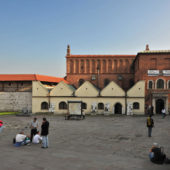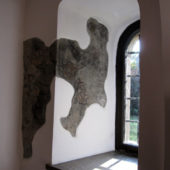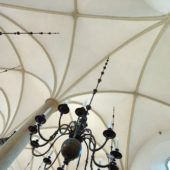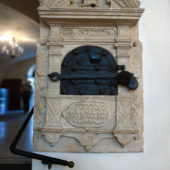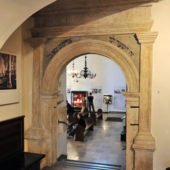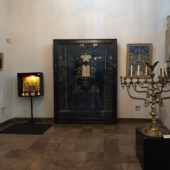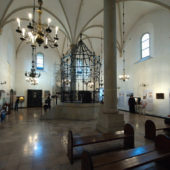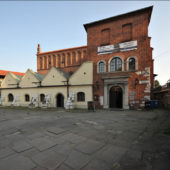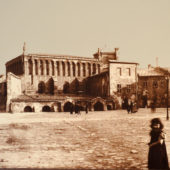The oldest synagogue in Poland and perhaps grandest of Krakow’s seven synagoues.
The Stara (old) Synagogue in Krakow, is the oldest synagogue in Poland, and arguably not only the oldest but also the grandest of Krakow’s seven synagogues. All seven synagogues are located in the Kazimierz district earmarked in 1495 by King Jan I Olbracht for the Jews to live in. The Synagogue was built in the 15th century and initially, it was all-male. It was constructed as a Gothic, rectangular, two-nave building, with cross-ribbed vaulting supported on two columns, and a gabled roof, similar to Jewish prayer houses in Prague, Worms and Regensburg.
In the second half of the 16th century, a vestibule in the northwestern corner and a prayer room for women at the western wall were added. However, later in the 16th century, the Synagogue suffered severe damage due to a fire and was rebuilt under the supervision of architect Mateo Gucci in approximately 1570. The Gothic style was maintained, but an element of Renaissance styling was added, along with several extensions. The walls were made higher and crowned with an arcaded parapet, which survives to this day in its original form. Inside, the original cross-ribbed vaulting, supported on tall Tuscan columns, was restored. The bimah and Aron Kodesh were Renaissance design. At the end of the 16th century, further prayer rooms for women were added.
It was from this Synagogue in 1775 that Tadeusz Kosciuscko encouraged the Jewish community to become a part of the national insurrection for freedom from Poland. (He also supported the American War of Independence.) In the years surrounding WWI famed Krakow architect Zygmunt Hendel added Neo-Renaissance detail to the structure. A colonnade porch was added, the rooms above the vestibule were provided a new, broad staircase and a decorative fence surrounded the perimeter of the Synagogue.
During the Nazis occupation of Krakow during WWII, the Kazimierz district became the Jewish ghetto and the Stara Synagogue was turned into a warehouse. The interior was destroyed and the beautiful ceiling purposely ruined. Most of its artwork and relics were stolen. Priceless religious artifacts were taken to Wawel Castle, to be used by Hans Frank. At the end of 1944 the vaulting collapsed, or perhaps was purposely destroyed. From 1955 to 1957, a three-stage general renovation was undertaken, which substantially altered the look of the Synagogue, enriching it with Neo-Renaissance detailing. The restoration included a new bimah, Aron Kodesh, main portal and restoration of the Baroque treasury box. Uncovered wall paintings were restored and annexed rooms were renovated. As part of the project, the Synagogue also became the Historical Museum of Krakow in 1959. The goal of the museum was to present the history and culture of the Jewish people of Poland. On display are such items of everyday life as birth, marriage and death certificates; circumcision knives; Torah scrolls; shofars; children’s amulets; and paintings, engravings and photographs depicting everyday life and the martyrdom of Jews in the Kazimierz district. As well as the permanently displayed collection, the museum often presents exhibitions featuring the life and culture of Polish Jews prior to 1939.
The façade of Stara Synagogue is built of brick in Neo-Renaissance design, featuring arched windows, echoed in the arched detailing on the second and third stories. Inside the massive prayer room, the white ceiling features Gothic sweeping arches with taupe outlining, tapering down to taupe columns on the ground floor. The elevated Aron Kodesh up a flight up stone steps. It is hand carved of stone and flanked on each side by pilasters. Black wrought iron stair-rails line the sides of the steps and gold menorahs stand on each side of the Aron Kodesh. A spectacular stone bimah is situated in the center of the prayer room, with a black wrought-iron gazebo, with entrances on either side. Inside is a tivah (prayer desk). Graceful wrought-iron and brass chandeliers drop down throughout the sanctuary. Arched windows flank the side-walls of the prayer room. The floor is made from the same stone as the Aron Kodesh and bimah.
The Jewish people have a long history in Poland. They first arrived in the late 13th century with German immigrants traveling on a commercial route to Prague. Kazimierz, just outside central Krakow today, was the primary Jewish settlement. By the 14th century a Jewish community was established in Kazimierz. In the 15th century there were increasing tensions between Jews and their Christian neighbors. In 1407 construction began of the oldest medieval synagogue preserved in Poland. Jacob Pollack settled in Kazimierz and established the first yeshiva, and subsequently Talmudic learning began to spread throughout Poland.
In 1485 Jews were forced, under duress, to sign an agreement, which barred them from undertaking many forms of commerce. In 1495 Jews were expelled from Krakow, by order of the King. In the 16th century an influx of Jews from Germany, Italy, Spain and Portugal came to Kazimierz. Rabbi Moses ben Isserles, known for his commentaries on the religious code of Ashkenazic and Sephardic Jews, lived in Kazimierz. His works were printed on a Hebrew printing press in the 1530s. In the 17th century there were intense struggles between Jewish and Christian merchants over Jewish commercial rights in Christian sectors. In 1609 an agreement was made allowing Jews to trade freely in Kaimierz and another town, but their trade was limited in Krakow, dependent upon bribery.
By 1644 seven synagogues were functioning in the Krakow – Kazimierz area. Yeshivot were founded in the late 16th century, establishing Krakow as a seat of Jewish learning. Krakow-Kazimierz became one of the most important communities in the Council of the Lands, the councils of Jewish communities in Poland in charge of Jewish livelihood. These oversaw municipal affairs, disputes, loans, fairs, commerce, interaction with non-Jews, Torah study, appointment of Rabbis and tax collection, as well as punishment for infractions of rulings. In the 1630s, many German Jews fleeing from the Thirty Years’ War immigrated to Krakow. In the 18th century, laws were imposed against the Jews limiting their rights.
In 1830 a Jewish elementary school was opened to serve the community of about 10,800 Jews. The first Reform synagogue opened in Krakow in 1844. In 1900 the Jewish population reached 25,670 people. By 1931 the Jewish community reached 56,800 members and Krakow was a center of Jewish political and social life in Poland. When WWII began, there were 60,000 Jews living in Krakow. The Nazis occupied the city on September 6, 1939. In April of 1940, Jews were ordered to leave the city within four months. 35,000 Jews left the city and 15,000 were allowed to remain. Krakow was the Nazi-occupied capital of Poland. On March of 1941, a ghetto housing 20,000 Jews, was built in Krakow’s Kazimierz district (this included Jews from neighboring towns). Only 2,000 Jews from Krakow survived WWII. Fearful of pogroms, the Jewish community dwindled in size so that by 1968 there were only about 700 Jews in Krakow. Today there are approximately 1,000, but only 200 identify themselves as members of the Jewish community.
Since 1961 Stara Synagogue has served as a museum, 6 days a week, Monday through Sunday.

